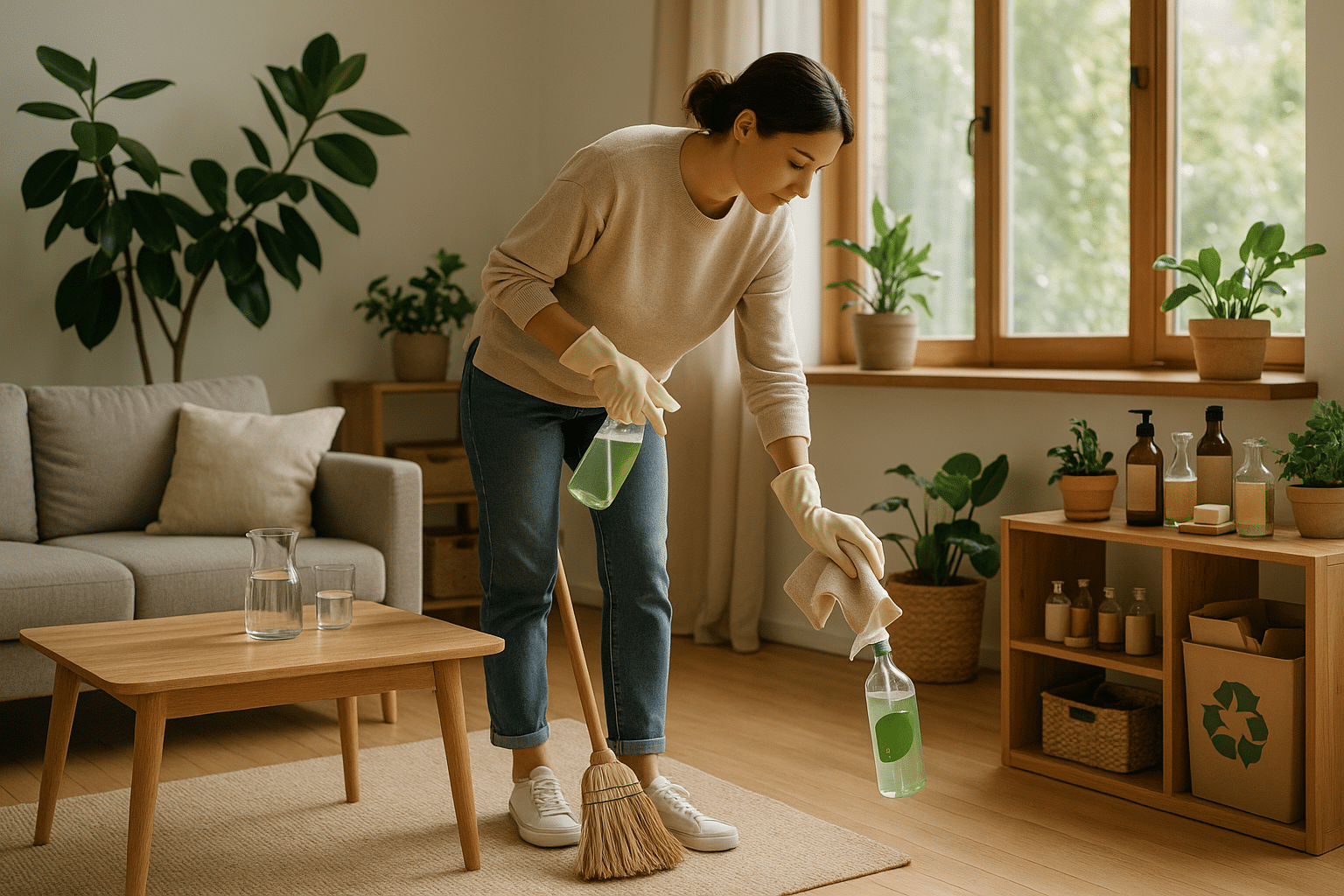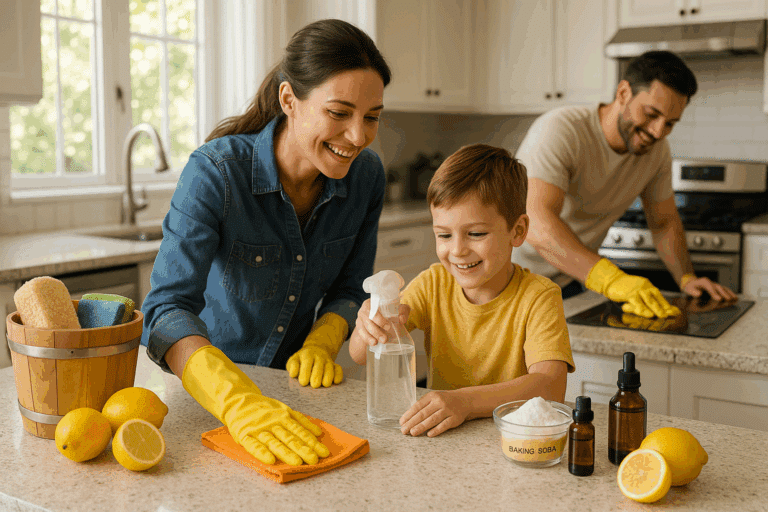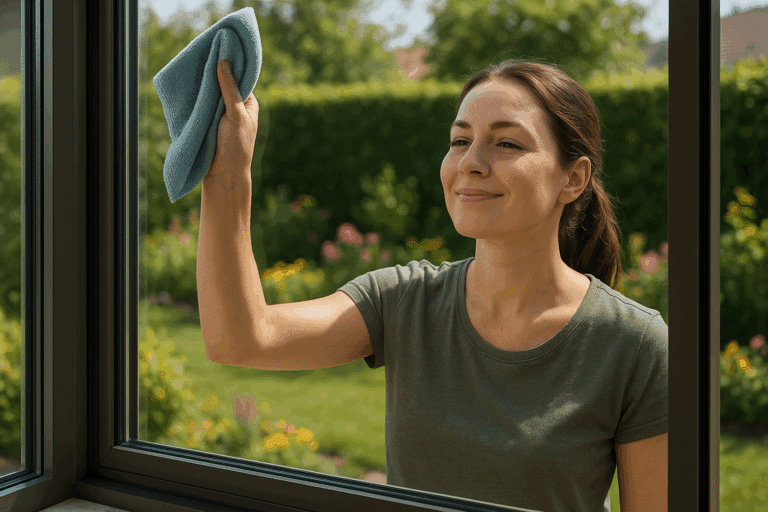But with the rising environmental concerns, a clean space shouldn’t mean a polluted planet. Let’s talk about eco-friendly cleaning solutions that can keep your place spotless and sustainable.
In today’s world, going green is more than a trend. It’s a commitment to reduce our carbon footprint and nurture a healthier planet. 🌍 With this in mind, many property owners are looking for green ways to maintain their spaces, especially when it comes to cleaning.
Why Opt for Eco-Friendly Cleaning?
Eco-friendly cleaning isn’t just about using products labeled as ‘natural’ or ‘green’. It’s about creating a safer, healthier environment for your guests, while also being conscious of the impact on our planet. But, how exactly can eco-friendly cleaning benefit you as a rental property or Airbnb host?
For starters, eco-friendly cleaning solutions are less toxic, reducing the risk of allergies and health problems for both your guests and your cleaning staff. They also contribute to air quality, since many conventional cleaning products release harmful chemicals into the air. But perhaps most importantly, opting for eco-friendly cleaning demonstrates your commitment to sustainability, which can attract like-minded guests and boost your reputation.🌱
What’s in Store?
In this comprehensive guide, we will delve into the world of eco-friendly cleaning for rental properties and Airbnbs. We’ll explore the ingredients to watch out for in conventional cleaning products, introduce you to green alternatives, and provide practical tips on sustainable cleaning practices.
We’ll start by discussing the harmful substances often found in conventional cleaning products and the risks they pose. From phthalates and parabens to volatile organic compounds (VOCs), we’ll demystify these complex terms and explain why they are best avoided.
Next, we’ll introduce you to eco-friendly cleaning solutions. From DIY cleaning products to commercially available options, we’ll cover a range of alternatives that are effective and environmentally friendly.
And because we understand that switching to eco-friendly cleaning involves more than just changing products, we’ll also provide practical tips on sustainable cleaning practices. This includes advice on reducing water usage, proper disposal of cleaning waste, and more.
Finally, we’ll look at how you can effectively communicate your eco-friendly cleaning practices to your guests. After all, your commitment to sustainability can be a strong selling point, and we’ll show you how to leverage this in your marketing.
Ready to Get Started?
So, are you ready to make your rental property or Airbnb more environmentally friendly? 😃 Whether you’re just beginning your green journey or looking to take it to the next level, this guide is for you. Let’s dive in and explore how you can keep your space spotless and sustainable!
Stay tuned, as this comprehensive guide is designed to provide you with all the information you need to implement eco-friendly cleaning solutions for your rental property or Airbnb. Let’s make the world a better place, one clean space at a time!
🌱 Introduction: The Call for Eco-Friendly Cleaning Solutions
As society grows more conscious of our environmental impact, we are increasingly seeking out green solutions in all aspects of life, and cleaning is no exception. In particular, the short-term rental industry, including properties listed on platforms like Airbnb, has a unique opportunity to lead the way in eco-friendly practices. In this article, we’ll delve into the world of eco-friendly cleaning solutions for rental properties and Airbnbs, offering an informative guide on how to keep your space spotless while minimizing your environmental footprint. Let’s dig in!
💧 Why Choose Eco-Friendly Cleaning Solutions?
Before we get into the nitty-gritty of green cleaning, let’s discuss why it matters. Traditional cleaning products are often packed with harmful chemicals that can be detrimental to our health and the environment. These chemicals can pollute our air and water, disrupt wildlife, and contribute to health issues for people using the products or living in cleaned spaces. On the other hand, eco-friendly cleaning solutions are designed to be non-toxic, biodegradable, and gentle on the environment, making them a much healthier and sustainable choice.
It’s also worth mentioning that opting for eco-friendly cleaning can also enhance your rental property’s appeal. Nowadays, many guests value and seek out accommodations that prioritize sustainable practices. Therefore, using eco-friendly cleaning solutions can help differentiate your property and attract a larger audience.
To provide a clearer understanding of the difference between traditional and eco-friendly cleaning products, let’s have a look at the comparative table below:
| Aspect | Traditional Cleaning Products | Eco-Friendly Cleaning Products |
|---|---|---|
| Ingredients | Chemical-heavy | Plant-based, non-toxic |
| Environmental Impact | Potential air and water pollution | Minimal impact, biodegradable |
| Health Risks | Potential allergenic and toxic | Generally safe for humans and pets |
| Guest Appeal | Standard | Attracts eco-conscious guests |
🍋 Choosing the Right Eco-Friendly Cleaning Solutions
Now that we understand the importance of eco-friendly cleaning solutions, how do we go about choosing the right ones? The market is now flooded with ‘green’ products, but not all are created equal. Here are some tips to help you navigate the eco-friendly cleaning product market:
- Check the labels: Look for products that are labeled as non-toxic, biodegradable, and made from renewable resources. Beware of vague or misleading terms like ‘natural’ or ‘eco-friendly’, which don’t necessarily guarantee the product is truly green.
- Research the company: It’s worth doing a bit of research into the company behind the product. Are they transparent about their ingredients and manufacturing processes? Do they have a commitment to sustainability beyond just their products?
- Consider DIY: Another option is to make your own cleaning solutions using household items like vinegar, baking soda, and lemon. This can be a cost-effective and low-waste option.
For a detailed guide on making your own cleaning products, I recommend the video ‘DIY Natural Cleaning Products | Easy Recipes for Cleaning Products’ by Clean My Space on YouTube. It provides an easy-to-follow guide on making a range of green cleaning solutions at home.
🌿 Implementing Eco-Friendly Cleaning Practices in Your Rental Property
Choosing eco-friendly cleaning products is a great start, but there’s more to sustainable cleaning than just the products you use. Here are some practices you can implement to make your cleaning routine even greener:
- Use microfiber cloths: Unlike disposable wipes or paper towels, microfiber cloths can be washed and reused many times, reducing waste. They’re also effective at cleaning surfaces without the need for harsh chemicals.
- Implement a recycling system: Make sure you have a clear and easy-to-use recycling system in your rental property. This not only reduces waste but also encourages guests to recycle.
- Buy in bulk: Purchasing cleaning products in bulk reduces the amount of plastic packaging used, leading to less waste. Just make sure to store bulk products safely away from children and pets.
By incorporating these practices, you can further reduce your environmental impact and set an example for guests. So, why not start implementing these eco-friendly cleaning solutions in your rental property today? Remember, every small step counts towards a more sustainable future.

Conclusion
In conclusion, we have deeply explored the intricate facets of the topic at hand in this article, breaking down complex concepts into understandable terms for all our readers. The relevance of this subject in our current technologically advanced era cannot be overstated. Moreover, the potentially enormous impacts on our lives and businesses are significant, making it an essential area of study and understanding for us all.
We have walked through the intricacies of software engineering and the role it plays in shaping our digital world. Notably, we have underscored the foundational knowledge in this domain, touching on the principles and practices that guide this field. We have also shed light on the different methodologies adopted in software development and highlighted the benefits and drawbacks of each. Throughout the discourse, the emphasis has been on the importance of adopting the right approach based on the specific requirements of a project.
Furthermore, we delved into the current trends in the industry and the future prospects, providing valuable insights for those interested in exploring this domain further. In particular, we explored the burgeoning role of artificial intelligence in software engineering and its potential to revolutionize the field.
Lastly, we examined the importance of effective communication in the context of software engineering. We emphasized the role of technical writing in communicating complex ideas in a simple, comprehensible manner, making it an essential skill for professionals in this field.
However, it is crucial to remember that this is a rapidly evolving field, and staying updated with the latest developments is key. Therefore, continuous learning is encouraged, and we hope this article has sparked your interest and motivated you to delve deeper into this subject.
We highly appreciate your engagement with this content and encourage you to share it within your networks. If you found this article beneficial, please feel free to comment, share, or apply what you have learned. Remember, knowledge is best utilized when shared! 👏👩💻🚀
For more insightful articles on topics like this, stay tuned to our page. And if you are interested in going deeper into the subject matter, we recommend these resources for further reading:
– “Software Engineering: Trends and Prospects”
– “Principles and Practices of Software Engineering”
Remember, the journey of knowledge is endless, and every step counts. Keep exploring, keep learning! 📚🌐💡
References
– G. Booch, et al. “Characterizing the Architecture of Intelligent Systems“, IBM Systems Journal, vol. 38, no. 1, pp. 104-120, 1999.
– I. Sommerville. “Software Engineering“, Addison-Wesley, 2010.
Please note, due to the rapid pace of technological development, some external resources may no longer be available. Always ensure to cross-verify information from multiple sources.



